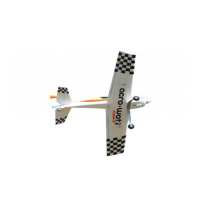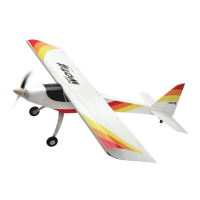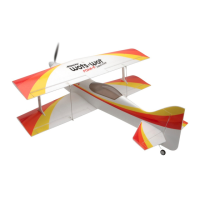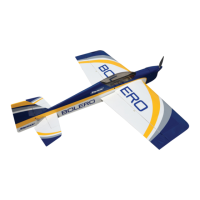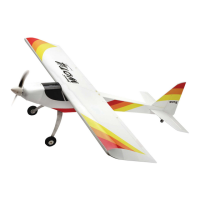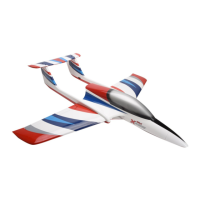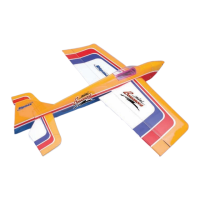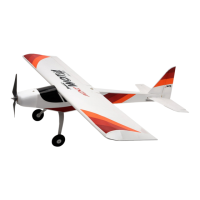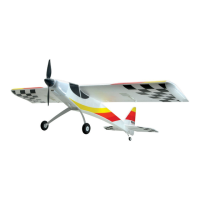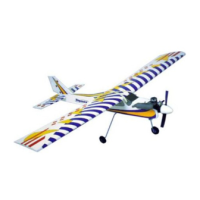Do you have a question about the Ripmax Acro Wot mk2 and is the answer not in the manual?
Biography of Chris Foss, the designer of the Acro Wot Mk2.
Step-by-step guide to attaching the pre-trimmed canopy.
Attaching the pre-trimmed canopy using screws or glue.
Instructions for fitting ailerons and joining the wing panels.
Preparing aileron hinges and applying glue for installation.
Positioning ailerons and ensuring a gap-free hinge line.
Preparing the wing joining brace and applying epoxy.
Inserting the wing joining brace into one wing panel.
Joining the two wing panels together with epoxy.
Connecting servo extensions to aileron servos securely.
Installing the aileron servos into their mounts.
Attaching control horns to the ailerons.
Mounting control horns and securing clevises.
Connecting pushrods to aileron horns and bending them.
Securing the aileron pushrods and trimming excess wire.
Adjusting aileron pushrods for correct centering.
Assembling and tightening the main undercarriage axles.
Fitting and securing the wheels onto the axles.
Mounting the main undercarriage to the fuselage.
Installing the tailwheel assembly.
Mounting the tailwheel assembly in line with the fuselage rear.
Preparing fuselage slots for tailplane and control linkages.
Removing film from the fuselage slot for the fin.
Positioning and centering the tailplane in its slot.
Preparing the tailplane slot for gluing by removing film.
Positioning the fin and marking its entry points.
Preparing the fin slot for gluing by removing film.
Ensuring fin and tailplane edges are firmly adhered.
Loosely positioning the elevator joiner at the tailplane slot.
Gluing the tailplane in position, checking alignment.
Inserting hinges into elevator halves and applying glue.
Applying epoxy to the elevator slot for the wire joiner.
Attaching the first elevator, ensuring proper hinge alignment.
Repeating elevator attachment and securing with tape.
Gluing the fin in position, ensuring it is square to the tailplane.
Inserting hinges into the rudder and applying glue.
Preparing the rudder for the closed loop horn.
Assembling the closed loop horn from hardware.
Applying epoxy to the rudder slot and positioning the rudder.
Adding glue to rudder hinges for secure attachment.
Installing the elevator pushrod through the fuselage.
Attaching the elevator horn to the elevator.
Installing servos in the pre-fitted radio tray.
Preparing the closed loop wire for rudder control.
Connecting clevises to rudder servos and routing wires.
Completing the closed loop connections for the rudder.
Bending the elevator pushrod at a 90° angle.
Attaching the bent elevator pushrod to the servo horn.
Mounting the engine mount onto the fuselage bulkhead.
Positioning the four-stroke engine on the mount.
Marking engine mounting hole positions on the mount.
Drilling clearance holes for the engine mounting bolts.
Preparing the fuel tank for installation.
Installing the fuel tank into the radio bay.
Securing the engine and installing the throttle linkage.
Preparing the throttle servo horn.
Adjusting the throttle linkage for correct operation.
Connecting fuel and pressure lines to the engine.
Trimming and fitting the fibreglass cowl.
Positioning the two-stroke engine on the mount.
Marking mounting hole positions for the two-stroke engine.
Installing the fuel tank for the two-stroke engine.
Securing the two-stroke engine and installing its throttle linkage.
Adjusting the two-stroke throttle linkage.
Connecting fuel and pressure lines for the two-stroke engine.
Trimming and fitting the cowl for the two-stroke engine.
Installing the radio switch on the fuselage.
Installing the receiver and battery in the radio bay.
Essential checks to perform before each flight.
| Rec. Radio | 4 channel |
|---|---|
| Servos | 4 standard servos |
| Skill Level | Intermediate |
| Wing Area | 34.5 dm² |
| Rec. Engine | 2-stroke or 30-52 4-stroke |
| Material | Balsa/Ply |
